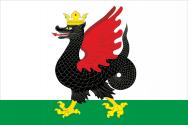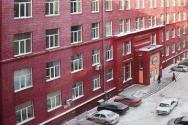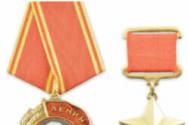Structure and functions of microtubules. Microfilaments Microtubules structure and functions table
A separate group of cytoskeletal proteins consists of microtubule proteins. These include tubulin, microtubule-associated proteins (MAP 1, MAP 2, MAP 4, tau, etc.) and translocator proteins (dynein, kinesin, dynamin). Microtubules are protein tubular structures with a diameter of about 25 nm and a length of up to several tens of micrometers; the thickness of their walls is about 6 nm. They are an essential component of the cytoplasm of eukaryotic cells. Microtubules form the spindle (achromatinous figure) in mitosis and meiosis, the axoneme (central structure) of motile cilia and flagella, the wall of centrioles and basal bodies. Microtubules play an important, if not key, role in cell morphogenesis and in some types of cell motility.
The walls of microtubules are built from the protein tubulin, which accounts for 90% by weight. Tubulin is a globular protein that exists as a dimer of α- and β-subunits with a molecular weight of ~55 kDa. The microtubule has the shape of a hollow cylinder, the wall of which consists of linear chains of tubulin dimers, the so-called protofilaments. In protofilaments, the α subunit of the previous dimer is connected to the β subunit of the next one. Dimers in adjacent protofilaments are displaced relative to each other, forming helical rows. A cross section shows 13 tubulin dimers, corresponding to 13 protofilaments in
microtubule wall (Fig. 9). Each subunit contains about 450 amino acids and the amino acid sequences of the subunits are approximately 40% homologous to each other. Tubulin is a GTP-binding protein, the β-subunit containing a labilely bound GTP or GDP molecule that can exchange with GTP in solution, and the α-subunit containing a tightly bound GTP molecule.
Rice. 9. Structure of a microtubule.
Tubulin is capable of spontaneous polymerization in vitro. Such polymerization is possible at physiological temperatures and favorable ionic conditions (absence of Ca2+ ions) and requires the presence of two factors: a high concentration of tubulin and the presence of GTP. Polymerization is accompanied by hydrolysis of GTP, and tubulin in the microtubule remains bound to GDP, and inorganic phosphate goes into solution.
Tubulin polymerization consists of two phases: nucleation and elongation. During nucleation, seeds are formed, and during
elongation - their lengthening with the formation of microtubules. It should be noted that during tubulin polymerization, subunits are added only at the ends of microtubules.
Opposite ends of microtubules differ in growth rates. The fast-growing end is usually called the plus end, and the slow-growing end is called the minus end of the microtubule (see Fig. 9). In a cell, the (–) ends of microtubules are usually associated with the centrosome, while the (+) ends are directed toward the periphery and often reach the very edge of the cell.
Microtubules are susceptible dynamic instability.
At a constant amount of polymer, spontaneous growth or shortening of individual microtubules occurs until their complete disappearance. Due to the delay in GTP hydrolysis relative to the incorporation of tubulin, a GTP cap consisting of 9-18 GTP-tubulin molecules is formed at the end of a microtubule in the process of growth. The GTP cap stabilizes the end of the microtubule and promotes its further growth. If the rate of incorporation of new heterodimers is less than the rate of GTP hydrolysis or in the case of mechanical rupture of the microtubule, an end devoid of the GTP cap is formed. This end has a reduced affinity for new tubulin molecules; he starts to figure it out.
Polymerization and depolymerization of microtubules are induced by changes in temperature, ionic conditions, or the use of special chemical agents. Among the substances that cause irreversible disassembly, indole alkaloids (colchicine, vinblastine, vincristine, etc.) are widely used.
PROTEINS ASSOCIATED WITH MICROTUBLES
Microtubule-associated proteins are divided into two groups: structural MAP (microtubule-associated proteins) and microtubule-associated proteins.
translocators.
Structural IDAs
A common property of structural MAPs is their permanent association with microtubules. Another common property of this group of proteins is that, unlike translocator proteins, when interacting with tubulin, they all bind to the C-terminal part of a molecule of about 4 kDa in size.
There are high molecular weight MAP 1 and MAP 2, tau proteins with a molecular weight of about 60-70 kDa and MAP 4 or MAP U with a molecular weight of about 200 kDa.
Thus, the MAP 1B molecule (a representative of the group of MAP 1 proteins) is a stoichiometric complex of one heavy and two light chains; it is an elongated rod-shaped molecule 190 nm long, having at one end a globular domain with a diameter of 10 nm (apparently, a binding site for microtubules ); its molecular weight is 255.5 kDa.
MAP 2 is a thermostable protein. It retains the ability to interact with microtubules and remain in their composition in several cycles of assembly and disassembly after heating to 90°C.
Structural MAPs are able to stimulate initiation and elongation and stabilize finished microtubules; stitch microtubules into bundles. This cross-linking involves short α-
helical hydrophobic sequences at the N-terminus of MAP and tau, closing MAP molecules sitting on adjacent microtubules, like a zipper. The biological role of such cross-linking may be to stabilize the structures formed by microtubules in the cell.
To date, experimental studies have established that in addition to regulating the dynamics of microtubules, structural MAPs have two more main functions: cellular morphogenesis and participation in the interaction of microtubules with other intracellular structures.
Translocator proteins
A distinctive feature of proteins of this group is the ability to convert ATP energy into a mechanical force capable of moving particles along microtubules or microtubules along the substrate. Accordingly, translocators are mechanochemical ATPases, and their ATPase activity is stimulated by microtubules. Unlike structural MAPs, translocators are associated with microtubules only at the time of ATP-dependent movement.
Translocator proteins are divided into two groups: kinesin-like proteins (mediate movement from the (–) end to the (+) end of microtubules) and dynein-like proteins (movement from the (+) end to the (–) end of microtubules) (Fig. 10 ).
Kinesin is a tetramer of two light (62 kDa) and two heavy (120 kDa) polypeptide chains. Kinesin molecule

has the shape of a rod with a diameter of 2-4 nm and a length of 80-100 nm with two globular heads at one end and a fan-shaped extension at the other (Fig. 11).
Rice. 10. Translocator proteins.
In the middle of the rod there is a hinge section. The N-terminal fragment of the heavy chain, about 50 kDa in size, which has mechanochemical activity, is called the kinesin motor domain.
Rice. 11. The structure of the kinesin molecule.
Microtubules are constructed from the globular protein tubulin, which is a dimer of α- and β-subunits (53 and 55 kDa). α,β-heterodimers form linear chains called protofilaments. The 13 protofilaments form a cyclic complex, then the rings polymerize into a long tube. Like microfilaments, microtubules are dynamic polar structures with (+) and (-) ends. The (-) end is stabilized by binding to the centrosome (microtubule organizing center), while the (+) end is characterized by dynamic instability. It can either grow slowly or shorten quickly. Tubulin monomers bind GTP, cat. Slowly hydrolyzes to HDF. Two types of proteins are associated with microtubules - structural proteins (MAP - microtubuls-associated proteins) and translocator proteins (kinesins).
They are clearly visible in an electron microscope and can be detected, despite their small diameter, in a light microscope using a special method - immunofluorescence. The fact is that tubulins in the cells of all plants and animals are similar. Therefore, antibodies (see Antigen and Antibody) to tubulin obtained from the brain of cows or pigs will “recognize” microtubules in the cells of almost any organism. If small molecules of substances that glow when irradiated with blue-violet rays - fluorochromes - are chemically attached to antibody molecules in advance, then by the distribution of luminous complexes in the cells, you can see the location of microtubules in a microscope with a fluorescent attachment. Microtubules form a network in the cytoplasm of cells, and during division they form the mitotic apparatus. They are part of centrioles and basal bodies;
Microtubules of the basal bodies serve as seeds for the growth of microtubules of cilia and flagella, which ensure the beating of these organelles.
Cytoplasmic microtubules are involved, along with other components of the cytoskeleton, in maintaining cell shape and in the intracellular movement of various organelles and particles. In plant cells, microtubules determine the direction of fibers in the cell wall. During mitosis, they ensure the movement of chromosomes. In addition to tubulin, microtubules contain small quantities of various proteins (currently several dozen of them are known). These proteins vary greatly not only in different species of animals and plants, but also in different tissues of the same organism.
It is believed that these proteins provide specific functions of microtubules in various cells.
Functions of microtubules
1) Maintaining cell shape.
2) Intracellular transport of organelles and movement of chromosomes.
3) Other types of mechanical work (for example, the movement of cilia in the epithelium of the lungs, intestines and oviducts, the beating of the sperm flagellum).
4) Important functions during cell division.
Kinesin molecular motor
Kinesin is a component of the tubulin-kinesin chemomechanical transducer. Microtubule kinesins and tubulins form a molecular motor for intracellular transport of organelles and movement of chromosomes along microtubules during cell division. The movement of organelles along microtubules with the participation of kinesins occurs in the direction of the (+) end of the microtubules.
Organelles containing microtubules Organelles containing triplets of microtubules (centrioles and basal bodies) or an axoneme (cilia and flagella) are involved in chromosome segregation, ciliary flicker, and sperm movement. In almost all eukaryotic cells in the hyaloplasm one can see long, unbranched
microtubules. They are found in large quantities in the cytoplasmic processes of nerve cells, fibroblasts and other cells that change their shape. They can be isolated themselves or the proteins that form them can be isolated: these are the same tubulins with all their properties.
Organelles of a non-membrane structure include microtubules - tubular structures of various lengths with an outer diameter of 24 nm, a wall thickness of about 5 nm and a “lumen” width of 15 nm. They are found free in the cytoplasm of cells or as structural elements of flagella (spermatozoa), cilia (ciliated epithelium of the trachea), mitotic spindle and centrioles (dividing cells).
Microtubules are built by the assembly (polymerization) of the protein tubulin. Microtubules polar: they have the ends (+) and (-). Their growth comes from the special structure of non-dividing cells - microtubule organizing center, with which the organelle is connected by the end (-) and which is represented by two elements identical in structure to the centrioles of the cell center. Microtubule elongation occurs by attachment of new subunits at the end (+). In the initial phase, the direction of growth is not determined, but of the resulting microtubules, those that come into contact with their (+) end with a suitable target are retained. In plant cells that have microtubules, centriole-type structures have not been found.
Microtubules take part:
- in maintaining cell shape,
- in the organization of their motor activity (flagella, cilia) and intracellular transport (chromosomes in anaphase of mitosis).
The functions of intracellular molecular motors are performed by the proteins kinesin and dynein, which have the activity of the ATPase enzyme. During flagellar or ciliated movement, dynein molecules, attaching to microtubules and using the energy of ATP, move along their surface towards the basal body, that is, towards the (-) end. The displacement of microtubules relative to each other causes wave-like movements of the flagellum or cilia, prompting the cell to move in space. In the case of immobile cells, for example, the ciliated epithelium of the trachea, the described mechanism is used to remove mucus from the respiratory tract with particles settling in it (drainage function).
The participation of microtubules in the organization of intracellular transport illustrates the movement of vesicles (vesicles) in the cytoplasm. Kinesin and dynein molecules contain two globular “heads” and “tails” in the form of protein chains. With the help of their heads, proteins contact microtubules, moving along their surface: kinesin from end (-) to end (+), and dynein in the opposite direction. At the same time, they pull behind them bubbles attached to their “tails”. Presumably, the macromolecular organization of the “tails” is variable, which ensures recognition of various transported structures.
Microtubules, as an essential component of the mitotic apparatus, are associated with the divergence of centrioles to the poles of a dividing cell and the movement of chromosomes in anaphase of mitosis. Animal cells, cells of parts of plants, fungi and algae are characterized by a cellular center (diplosoma), formed by two centrioles. Under an electron microscope, the centriole looks like a “hollow” cylinder with a diameter of 150 nm and a length of 300-500 nm. The cylinder wall is formed by 27 microtubules, grouped into 9 triplets. The function of centrioles, similar in structure to the elements of the microtubule organization center (see here, above), includes the formation of mitotic spindle threads (division spindle, achromatin spindle of classical cytology), which are microtubules. Centrioles polarize the process of cell division, ensuring the natural divergence of sister chromatids (daughter chromosomes) to its poles in anaphase of mitosis
Kinesin structure (a) and vesicle transport along a microtubule (b)
Around each centriole there is a structureless, or fine-fibrous, matrix. You can often find several additional structures associated with centrioles: satellites, microtubule convergence foci, additional microtubules forming a special zone, a centrosphere around the centriole.
CYTOSKELETON
Cytoskeleton is a complex dynamic system microtubules, microfilaments, intermediate filaments and microtrabeculae. These cytoskeletal components are non-"swearing organelles; each of them forms in the cell 3D network with a characteristic distribution that interacts with networks of other components. They are also part of a number of other more complexly organized organelles (cilia, flagella, microvilli, cell center) and cellular compounds (desmosomes, hemidesmosomes, encircling desmosomes).
Main functions of the cytoskeleton:
1 maintaining and changing cell shape;
2 distribution and movement of cell components;
3 transport of substances into and out of the cell;
4 ensuring cell motility;
5participation in intercellular connections.
Microtubules
Microtubules, - the largest components of the cytoskeleton. They are hollow cylindrical formations in the shape of tubes, up to several micrometers long (in flagella more than 50 nm) with a diameter of about 24-25 nm, with a wall thickness of 5 nm and a lumen diameter of 14-15 nm (Fig. 3-14) .
Microtubule wall consists of spirally arranged threads - protofilaments 5 nm thick (which correspond to 13 subunits in a cross section), formed by dimers from protein molecules a~ And /3-tubulin.
Functions of microtubules:
(1) maintaining the shape and polarity of the cell, the distribution of its components,
(2) ensuring intracellular transport,
(3) ensuring the movement of cilia and chromosomes in mitosis(form the achromatin spindle necessary for cell division),
(4) formation of the basis of other organelles(centrioles, cilia).
Arrangement of microtubules. Microtubules are located in the cytoplasm as part of several systems;
a) in the form of separate elements, scattered throughout the cytoplasm and forming networks;
b) in bundles, where they are connected by thin cross bridges (in the processes of neurons, as part of the mitotic spindle, spermatid cuff, peripheral “ring” of platelets);
c) partially merging with each other to form steam, or doublets(in the axoneme of cilia and flagella), and triplets(in the basal body and centrioles).
Formation and destruction of microtubules. Microtubules are a labile system in which there is a balance between their constant assembly and dissociation. Most microtubules have one end (denoted as “-”) fixed, while the other (“+”) is free and participates in their elongation or depolymerization. The structures that ensure the formation of microtubules are special small spherical bodies - satellites { (from English, satellite - satellite), report- what the latter call microtubule organizing centers (MTOCs). . Satellites are contained in basal bodies of cilia and cellular cent- I tre
(See Figures 3-15 and 3-16). After the complete destruction of microtubules in the cytoplasm, they grow from the cell center at a speed of about 1 µm/min, and their network is restored again in less than an hour and a half. The centromeres of chromosomes also belong to the CMMT. carried out through a number of proteins that perform various functions. (1) Microtubules with the help of accessory proteins attached to other cellular components. (2) Along their length, microtubules form numerous lateral processes (which consist of microtubule-associated proteins) up to several tens of nanometers long. Due to the fact that such proteins sequentially and reversibly bind to organelles, transport vesicles, secretory granules and other formations, microtubules (which themselves do not have contractility) provide moving the indicated structures in the cytoplasm. (3) Some microtubule-associated proteins stabilize their structure, and by connecting with their free edges, prevent depolymerization.
Inhibition of microtubule self-assembly through a number of substances that are mitosis inhibitors(colchicine, vinblastine, vincristine), causes selective death of rapidly dividing cells. Therefore, some of these substances are successfully used for chemotherapy
PI of tumors. Microtubule blockers also disrupt transport processes in the cytoplasm, in particular, secretion and axonal transport in neurons. The destruction of microgrubs leads to changes in the shape of the cell and disorganization of its structure and distribution of organelles.
Cell center (cytocenter)
Cell center formed by two hollow cylindrical structures 0.3-0.5 long<мкм и диаметром 0.15-0.2 мкм - centrioles, which are located close to each other in mutually perpendicular planes (Fig. 3-15). Each centriole consists of 9 triplets partially fused microtubules (A, B and C), connected by cross-protein bridges ("handles"). In the central part of the centriole there are no microtubules (according to some data, there is a special central thread), which is described by the general formula (9*3) + 0. Each centriole triplet is associated with spherical bodies with a diameter of 75 nm - satellites; microtubules diverging from them form centrosphere.
In a non-dividing cell, one pair of centrioles is detected (diploso-ma), which is usually located near the nucleus. Before division in the S-ne-rhyde of interphase, centriole duplication pairs, and at right angles to each mature (maternal) a new centriole is formed (daughter), immature procentriole, in which at first there are only 9 single microtubules, which later turn into triplets. Pairs of centrioles further diverge to the poles of the cell, and during mitosis they serve centers for the formation of microtubules of the achromatin spindle.
Cilia and flagella
Cilia and flagella - organelles of special importance involved in movement processes - are outgrowths of the cytoplasm, the basis of which is microtubule frame, called axial thread, or axoneme(from the Greek axis - axis and peta - thread). Eyelash length is equal to 2-10 microns, and their quantity on the surface of one ciliated cell can reach several hundred. The only type of human cell that has a flagellum, sperm, contains only one flagellum. length 50-70 microns.
Axoneme formed by 9 peripheral pairs of microtubules and one centrally located pair; such a structure is described by the formula (9 x 2) + 2(Figure 3-16). Within each peripheral pair, due to partial fusion of microtubules, one of them (A) is complete, and the second (B) is incomplete (2-3 dimers are common with microtubule A).
The central pair of microtubules is surrounded central shell, from which they diverge to the peripheral doublets radial spokes. Peripheral doublets are connected to each other by bridges neck-sina, and from microtubule A to microtubule B of the neighboring doublet “handles” of protein extend dynein(see Fig. 3-16), which has ATPase activity.
Beating of cilia and flagellum is caused by the sliding of neighboring doublets in the axoneme, which is mediated by the movement of dynein handles. Mutations that cause changes in the proteins that make up the cilia and flagella lead to various dysfunctions of the corresponding cells. At Kartagener's syndrome (fixed cilia syndrome), usually caused by the absence of dynein handles, patients suffer from chronic diseases of the respiratory system (associated with impaired function of cleansing the surface of the respiratory epithelium) and infertility (due to sperm immobility).
basal body, similar in structure to the centriole, lies at the base of each cilium or flagellum. At the level of the apical end of the body, microtubule C of the triplet ends, and microtubules A and B continue into the corresponding microtubules of the axon of the cilium or flagellum. At development cilia or flagellum, the basal body plays the role of a matrix on which the assembly of axoneme components occurs.
Microfilaments
Microfilaments - thin protein filaments with a diameter of 5-7 n, lying in the cytoplasm singly, in the form of networks or in bunches. In skeletal muscle, thin microfilaments form ordered bunches, interacting with thicker myosin filaments.
Cortical (terminal) network - zone of condensation microfilaments under the plasmalemma, characteristic of most cells. In this network, Microfilaments are intertwined and “stitched” together using special proteins, the most common of which is filamin. The cortical network prevents sharp and sudden deformation of the cell under mechanical influences and ensures smooth changes in its shape through restructuring, which is facilitated actin-dissolving (converting) enzymes.
Attachment of microfilaments to the plasmalemma carried out due to their connection with its integral (“anchor”) proteins (integrins) - directly or through a series of intermediate proteins - talin, vinculin and ss-actinin(See Figure 10-9). In addition, actin microfilaments are attached to transmembrane proteins in special areas of the plasmalemma called adhesive connections, or focal contacts, that connect cells to each other or cells to components of the intercellular substance.
Actin - the main protein of microfilaments - occurs in monomeric form (G-, or globular actin), which is capable of polymerizing into long chains in the presence of cAMP and Ca 2+ (F-, or fibrillar actin). Typically, an actin molecule looks like two helically twisted filaments (see Figures 10-9 and 13-5).
In microfilaments, actin interacts with a number of actin-binding proteins(up to several dozen species) performing various functions. Some of them regulate the degree of actin polymerization, others (for example, filamin in the cortical network or fimbrin and villin in the microvillus) contribute to the binding of individual microfilaments into systems. In non-muscle cells, actin accounts for approximately 5-10% of the protein content, only about half of which is organized into filaments. Microfilaments are more resistant to physical and chemical influences than microtubules.
Functions of microfilaments:
(1) ensuring the contractility of muscle cells(when interacting with myosin);
(2) providing functions associated with the cortical layer of the cytoplasm and plasmalemma(exo- and endocytosis, formation of pseudopodia and cell migration);
(3) movement of oranellae, transport vesicles and other structures within the cytoplasm due to interaction with certain proteins (minimyosin) associated with the surface of these structures;
(4) ensuring a certain cell rigidity due to the presence of a cortical network, which prevents the action of deformations, but itself, being rearranged, contributes to changes in cellular shape;
(5) formation of a contractile constriction during cytotomy, completing cell division;
(6) formation of the basis ("framework") of some organelles(microvilli, stereocilia).
(7) participation in the organization of the structure of intercellular connections(girdling desmosomes).
Microvilli - finger-like outgrowths of the cell cytoplasm with a diameter of 0.1 μm and a length of 1 μm, the basis of which is formed by actin microfilaments. Microvilli provide multiple increase in surface area cells on which it occurs breakdown and absorption of substances. On the apical surface of some cells actively involved in these processes (in the epithelium of the small intestine and renal tubules) there are up to several thousand microvilli, which together form brush border.
The framework of each microvilli is formed a bundle containing about 40 microfilaments, lying along its long axis (Fig. 3-17). IN apical part microvilli this bundle is fixed in amorphous substance. Its rigidity is due to cross-links from proteins fimbrine And vilina, from the inside, the bundle is attached to the plasmalemma of the microvilli by special protein bridges (molecules minimyo- Z ina). At the base of the microvilli, the microfilaments of the bundle are woven into terminal network, among the elements of which there are myosin filaments. The interaction of actin and myosin filaments in the terminal network likely determines the tone and configuration of the microvillus.
Stereocilia - modified long (in some cells - branching) microvilli - are detected much less frequently than microvilli and, like the latter, contain a bundle of microfilaments.
Microfilaments (microfilamenti) are submicroscopic non-membrane organelles of general purpose that act as a cytoskeleton.
Depending on their structure and function, microfilaments are divided into:
1) Microfilaments themselves;
2) Intermediate microfilaments.
· Microfilaments themselves are characteristic of almost all cells and are localized in the cortical layer of the cytoplasm directly under the plasmalemma.
¨The structure is thin fibers, with a diameter of 5 to 7 nm, consisting of proteins: actin, myosin, tropomyosin, a-actinin.
¨Functions - microfilaments themselves are an intracellular contractile apparatus that provides not only cell motility, but also most intracellular movements, cytoplasmic flows, movement of vacuoles, mitochondria, cell division.
Intermediate microfilaments or microfibrils (microfibrillae) are the formation of a protein structure.
¨Structure - they are thin filaments, often arranged in bundles with a diameter of 10-15 nm. A characteristic feature is that their structural composition is different in different tissues. Epithelial microfilaments consist of a protein - keratin, in the cells of mesenchymal tissues of a protein - desmin.
¨Function - responsible for the cell maintaining its shape.
Microtubules
Microtubules (microtubuli) are submicroscopic membrane organelles, the main purpose of which is to create an elastic and at the same time stable cytoskeleton necessary to maintain the shape of the cell.
structure. Microtubules are built from globular proteins - tubulins, the molecules of which are able to polymerize in a special way, stringing one on top of the other, and forming round subunits 5 nm in size. The microtubule wall is composed of tightly packed subunits, with 13 subunits forming a microtubule ring. The outer diameter is about 24 nm, the inner lumen is 15 nm wide. Microtubules are part of complexly organized special organelles, such as centrioles and basal bodies, and are also the main structural elements of cilia and flagella.
function. In cells, microtubules take part in the creation of a number of temporary (cytoskeleton of interphase cells, spindle) and permanent structures (centrioles, cilia, flagella).
Cilia and flagella
These are special-purpose organelles found in some cells of various organisms.
Cilia(cilium) represent thin cylindrical outgrowths of the cytoplasm.
¨Dimensions - have a constant size of 200 nm and a length from 5 to 10 µm.
¨Structure - the cilium is covered from base to apex with a plasma membrane. Inside the outgrowth there is an axial thread (axoneme). The axoneme is a complex structure consisting mainly of microtubules. The proximal part of the cilium (basal body) is immersed in the cytoplasm. The diameter of the axoneme and basal body is about 150 nm.
Axoneme(filamentum axiale) consists of 9 doublets of microtubules, which, when connected by handles, form the wall of the axoneme cylinder. In the center of the axoneme there is a pore of central microtubules. The microtubule system of the axoneme has the formula (9x2)+2.
Basal body(corpusculum basale) consists of 9 triplets of microtubules connected to each other using handles. The microtubule system of the basal body has the shape (9x3)+0; as in the centriole. Sometimes at the base of the axoneme there may be a pair of basal bodies located at right angles to each other.
Axonemes and basal bodies are structurally interconnected and form a single whole: two microtubules of triplets of the basal body are microtubules of axoneme doublets.
Flagella(flagellum) are thin cylindrical outgrowths of the cytoplasm, which in their structure are similar to cilia.
¨Dimensions - diameter about 200 nm, length 150 microns.
Just like cilia, they have a basal body and an axoneme.
¨Functions - free cells with cilia and flagella have the ability to move, stationary cells can move fluid and carpuscular particles by the movement of cilia.
Inclusions
Cytoplasmic inclusions (inclusiones cytoplasmicae) are unstable components of the cell that appear or disappear depending on the metabolic state and do not have a strictly defined structure.
The following types of inclusions are distinguished:
Secretory;
Trophic;
excretory;
Pigmented.
Secretory inclusions- rounded, formations of various sizes that contain biologically active substances formed as a result of the secretory activity of the cell (hormones, enzymes, etc.)
Trophic inclusions- these can be droplets of neutral fats, glycogen, protein molecules in the form of granules.
Excretory inclusions- these inclusions do not contain enzymes or other active substances, and these products, as a rule, must be removed from the cell.
Pigment cells- can be exogenous (carotene, dust particles, dyes) and endogenous (hemoglobin, hemosiderin, bilirubin, melanin, lipofuscin). Their presence in the tissue can lead to a change in the color of the tissue or organ - temporarily or permanently.







